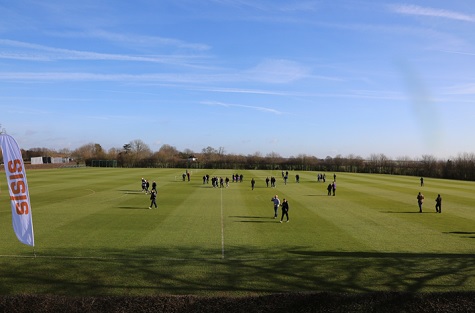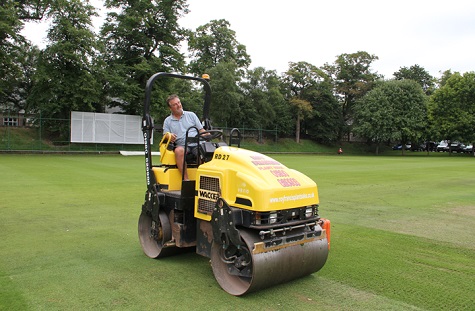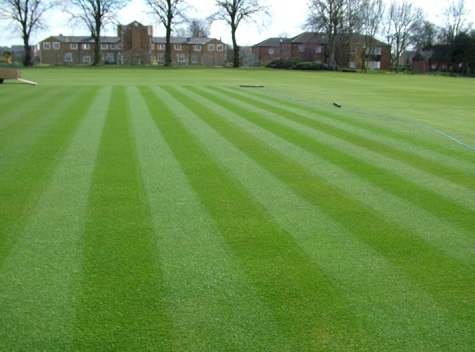After what I would consider a very mild winter and an exceptionally balmy February, we are now moving into a very busy March for both gardeners and groundsmen.
That recent spell of warm weather will have initiated a flush of growth with many spring flowering shrubs and trees coming into flower along with the need to start mowing your lawns.

As for cricket grounds it signals the start of a very busy year! Particularly for the professional County Cricket guys who will be hosting a number of International matches with the ICC Cricket World Cup and Ashes being hosted in the UK this year.
Starting with a one day, series match with England v Pakistan at Sophia Gardens, Cardiff on May 5th, followed by another 22 games with the last one being England V Australia at the KIA Oval London on the 12th September, there is certainly a very busy schedule this summer. See full listings here.
March / early April is one of the busiest periods for groundsmen. With pitch preparation and outfields to maintain, time management is vitally important. Many of you will be under pressure to get your facilities up to speed ready for the start of the season.
Priority will be focussed on your pre-season rolling programme. The length and time you spend on this work will be dependent on several factors. These include the window of opportunity you have - which is principally dependant on the weather - what soils you have plus what the condition they are in (they need to be in a drying state) and more importantly what size rollers you have available.

Other work to be getting on with will include some sorrel rolling to keep the surface open (remember to keep an eye out for disease and worms). Brushing or swishing of the square is a must to help reduce the incidence of both a disease outbreak and help disperse any unsightly worm casts.
The square now needs to be ‘squared off’ as well as locating each pitch to be used. A light Vert- cut or scarification of the square to remove lateral growth whilst mowing the square regularly will increase sward density. Fertilising the square with low nitrogen, higher potassium feed will harden the sward. Carry out renovations and overseed any remaining bare areas.
Pitch preparations should be started following the 10-12 day guidelines. Outfields will also need some attention to detail with a light harrow, aerating, top dressing and mowing @ 15-18mm. Re-commission your irrigation systems (if you have one) and check you have not had any frost damage. Keep records of work carried out such as, core samples, fertilising, mowing & rolling. Last but not least, don’t forget your boundary line!
With March being dry with higher temperatures, the use of covers is extremely helpful in the preparation. The ability to control the drying out of the soil profile is essential in the production of good wickets. However, there is a considerable skill in using covers, knowing when and how long to keep them on. Ideally having access to either flat or raised roll on roll off covers enables you to have greater scope in controlling the needs of your square. Flat sheet covers are usually used at the start of pitch preparations to control the moisture in the pitch during your early rolling, whilst the raised covers are used primarily for drying out the pitch before play.

Wicket Preparations
The 10-12 day prep shown below is only a guide; most turf professionals will have their own interpretation of these activities:
- DAY 1 String out pitch lines to ensure correct width, 10 ft; Mow out @ 8mm. Always double mow (up and down the same line), using an 8 bladed pedestrian cylinder mower for maintaining the square. Test the pitch with a key or knife for moisture. Water the pitch thoroughly in the event that the pitch has dried out through pre-season rolling.
- DAY 2 Brush / light rake, mow @ 8 mm, light roll to consolidate surface levels.
- DAY 3 Scarify or verti cut to remove lateral growth and surface thatch avoiding deep surface disturbance. Mow @ 7 mm. Remove biomass, continue medium light rolling 1000 kg 10-15 minutes.
- DAY 4 Test for moisture. Roll pitch increasing to consolidating surface with 1000 kg roller if available.
- DAY 5 Scarify with hand rake to remove any thatch build up Set & mow @ 6 mm. roll.
- DAY 6 Mow, roll 20-30 minutes.
- DAY 7 DAY OFF
- DAY 8 Light scarify by hand, mow @ 6 mm, increase weight of roller to 1500- 1700 kg continue rolling 30 minutes reducing speed to consolidate surface. Test for consolidation with key or knife for placidity.
- DAY 9 Continue to mow and rolling at slow speed to achieve consolidation. Cover pitch over night to encourage moisture to rise to surface.
- DAY 10 Brush / rake lifting any lateral grasses, reduce mower (with a shaver blade) to 4mm, try to avoid scalping. Roll using heavy roller slow speed (crawling) morning & again late afternoon where possible. Cover pitch over night.
- DAY 11 Brush & mow pitch, roll morning and afternoon slow as possible (crawling).
- DAY 12 Brush, mow & roll to polish surface, test bounce with an old ball along edge of pitch. Continue rolling to consolidate surface. Cover pitch over night.
- DAY 13 Brush, mow & roll polish up pitch. Your pitch should effectively have taken on a straw like coloration, a sign that the preparation has been achieved. String and mark out as in accordance to E.C.B guildlines.
The purpose of rolling is to squeeze any remaining air out of the pore spaces and to consolidate the surface up to 100mm. Rolling is best performed when there is sufficient moisture in the pitch before the ground dries out. In the event of drought, syringing is advisable to assist keying the surface and helps polish the pitch.
I am sure, we all will be entertained by this year’s feast of international cricket matches. I would like to take the opportunity to wish the county Test groundmen all the best. I am sure it’s going to be a long hard season for you all.

And finally, I would just like to mention that this year Cricket World have resurrected the Cricket Groundcare awards 2019. There will be seven award categories and the judging process will take into account the quality of the playing surface, general upkeep of the ground, longevity of service, an 'against all odds' and an overall Groundcare person of the Year. The winners will be invited to a special presentation at Lord’s Cricket Ground in London.
All you have to do to nominate your groundcare staff or individuals is to fill in the form online and it will go forward to the judging process.